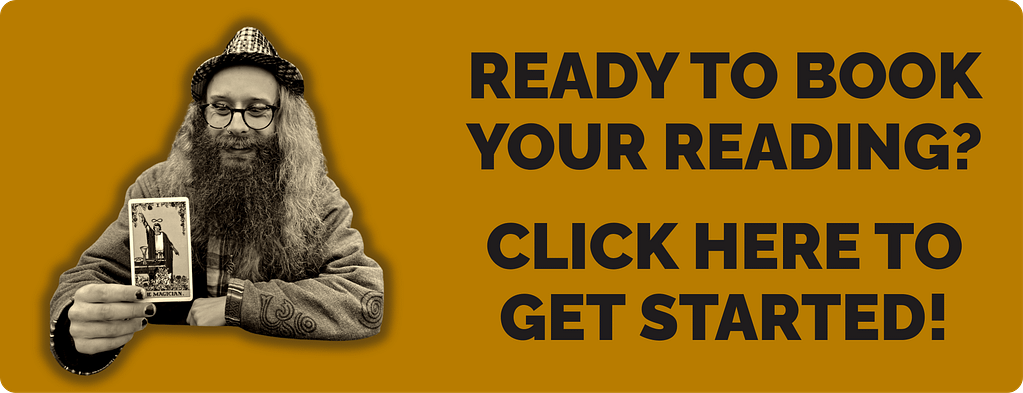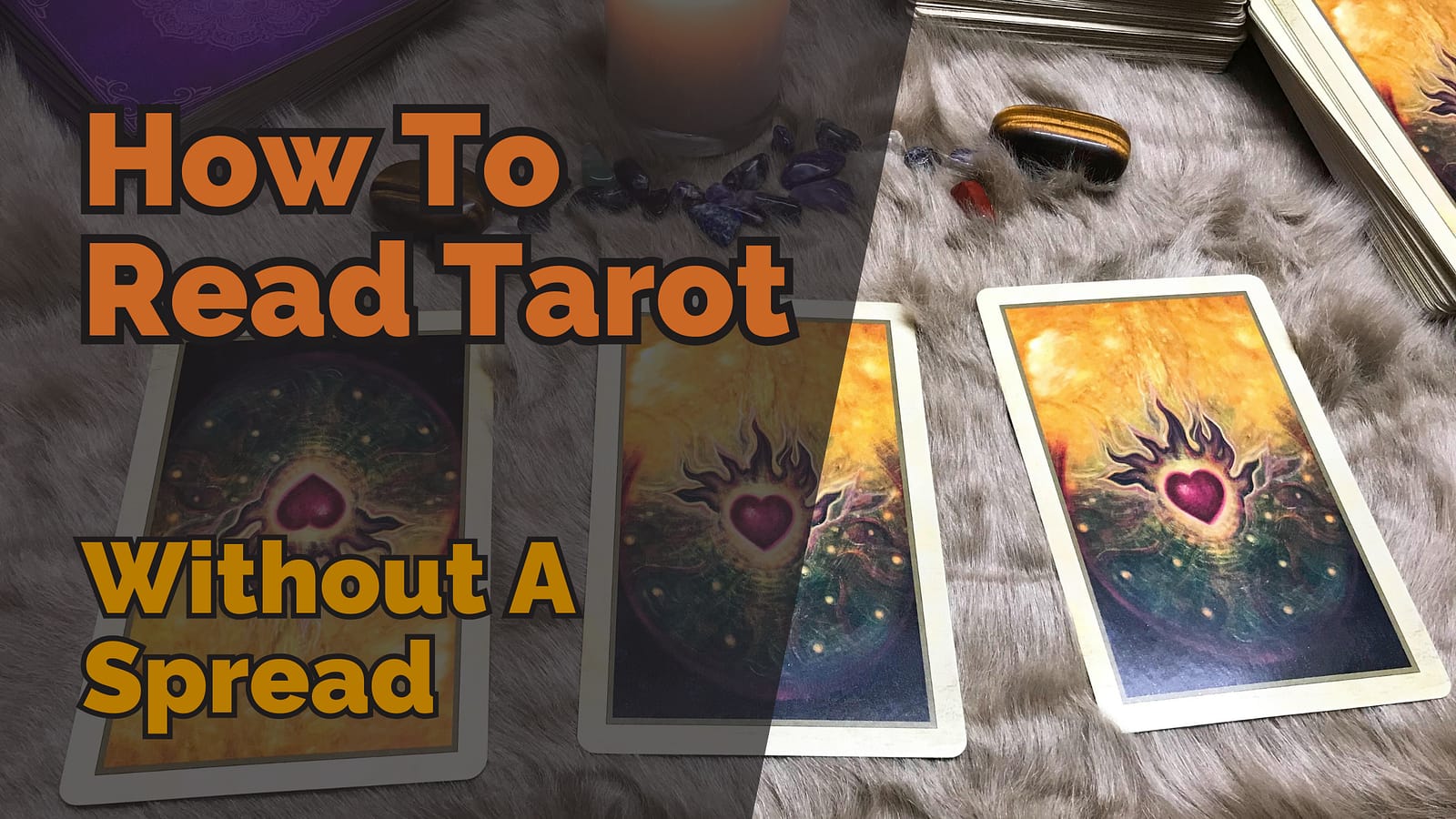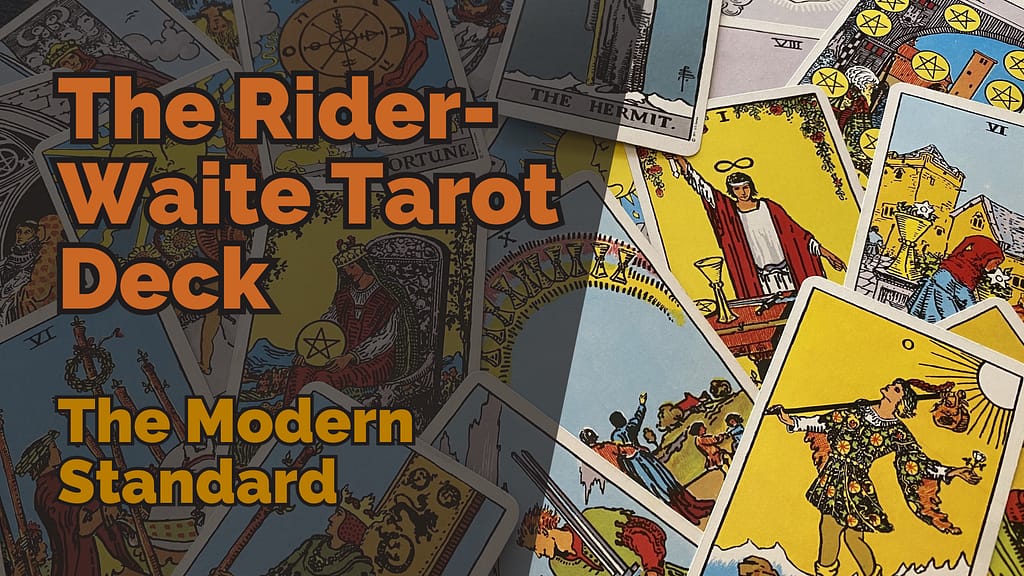
Table of Contents
Tarot today owes a lot to one deck. It’s likely the first one you saw, the first one you learned with, and the one most meanings are still based on. Whether you realise it or not, if you’ve used tarot, you’ve met the Rider-Waite Tarot Deck.
This is the fourth post in my Decks That Changed Tarot series. We’ve looked at the Visconti-Sforza deck’s opulence, the Marseille deck’s clean lines, and Etteilla’s wild esotericism. Now it’s time for the deck that became the blueprint.
The Rider-Waite Tarot Deck didn’t just build on what came before. It redefined tarot for the 20th century and beyond. It made card meanings visual. It normalised illustrated Minor Arcana. It quietly became the standard.
While this post focuses on the deck itself, it’s impossible not to touch on the key people involved: Arthur Edward Waite and Pamela Colman Smith. I’ll include a few key details, but if you want more on Pamela, check out my separate blog post about her.
Origins and Influences
The Hermetic Order of the Golden Dawn
The Golden Dawn was a secretive magical society formed in the late 19th century, deeply invested in ceremonial magic, astrology, and the Kabbalah. Their goal was to develop spiritual insight and access deeper levels of consciousness through esoteric study and ritual.
Their influence on the tarot was enormous. They assigned elemental, astrological, and Kabbalistic associations to each card, embedding multiple symbolic systems into the deck. Before them, tarot had been mostly a fortune-telling tool. The Golden Dawn made it a map of spiritual growth.
Arthur Edward Waite was a member of the Golden Dawn. His understanding of tarot was shaped by its teachings, but he also disagreed with some of its wilder interpretations. That tension would shape the Rider-Waite deck into something uniquely his.

Arthur Edward Waite’s Vision
Waite wasn’t just interested in magic for magic’s sake. He wanted tarot to be a spiritual text, a book of secrets. His goal was to encode deep truths into imagery that could be contemplated and studied.
He believed that earlier decks didn’t go far enough. The Marseille deck was too plain. Etteilla’s deck was too strange. So he decided to create a new one, one that could communicate both esoteric depth and intuitive symbolism.
To bring this vision to life, he commissioned an artist who was also a member of the Golden Dawn: Pamela Colman Smith.
Pamela Colman Smith’s Illustrations
Pamela Colman Smith, often known as “Pixie,” was a trained artist with a flair for the mystical. She had a background in theatre and illustration, and her style was expressive, emotional, and narrative-driven.
Although she wasn’t as high-ranking in the Golden Dawn as Waite, her understanding of its symbolism combined with her artistic instinct made her the perfect person for the job. She took Waite’s notes and transformed them into something magical.
Her greatest contribution? Giving the Minor Arcana scenes and stories. Before this deck, the numbered cards in most decks were just pips. Pamela turned them into visual metaphors that anyone could relate to, whether or not they had esoteric training.
What Makes the Rider-Waite Tarot Deck Unique
Fully Illustrated Minor Arcana
Before the Rider-Waite Tarot Deck, the Minor Arcana were often overlooked. They were simple suit symbols with little visual content. Pamela Colman Smith changed that by illustrating each one like a snapshot from a story.
The 5 of Pentacles doesn’t just show five coins. It shows two figures walking through snow, a stained-glass window behind them. The image evokes exclusion, hardship, and hope. Suddenly, a card that was once abstract became emotional.
This visual storytelling made tarot more accessible. Beginners could intuit card meanings from the images, even if they didn’t know the esoteric systems behind them. It also changed how tarot was taught. You didn’t have to memorise keywords, you could read the picture.
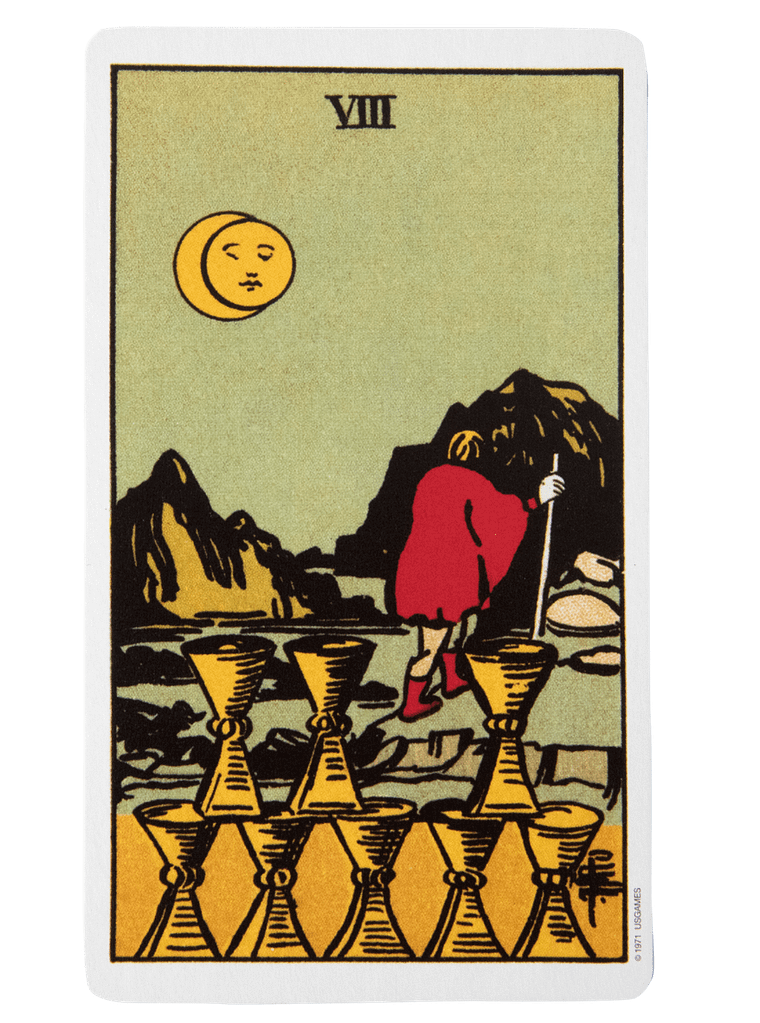
The Rider-Waite Tarot Deck Meanings
The meanings of tarot cards as we know them today largely stem from this deck. That’s not because it introduced new interpretations, but because it made them visible.
Take the 8 of Cups: a figure walks away from a stack of cups under a moonlit sky. It captures the essence of emotional withdrawal or spiritual seeking. These images embedded narrative into each card, creating a shared symbolic language.
The Rider-Waite Tarot Deck meanings are so influential that they’re now the default in most books and courses. Even modern decks often follow the same emotional and symbolic cues, whether consciously or not.
The Structure and Style
The deck consists of 78 cards: 22 Major Arcana and 56 Minor Arcana split into four suits (Cups, Wands, Swords, and Pentacles). Each suit includes 10 numbered cards and four Court Cards: Page, Knight, Queen, and King.
Waite made some tweaks to existing card order and symbolism, such as switching the positions of Strength and Justice to better align with his esoteric system. The overall structure reflects his desire for the deck to serve as a mystical journey.
Smith’s illustrations unify the deck visually. Even the borders, backgrounds, and skies contribute to the mood. Every card is its own world, but together, they tell a story that’s both mystical and deeply human.
Critiques and Considerations
Representation and Erasure
One of the most frequent critiques of the original Rider-Waite Tarot Deck is its lack of diversity. Most of the figures are white, thin, and cisgender. It presents a narrow vision of humanity that doesn’t reflect the world we live in.
Gender roles are also deeply traditional, with male authority figures and submissive female archetypes. Romantic pairings appear heterosexual by default. And although Pamela Colman Smith illustrated the entire deck, her name was excluded from the title for decades.
Today, many readers and creators are pushing back against this erasure. Giving Pamela her flowers, and acknowledging the limitations of the deck’s representation, is part of taking tarot seriously as a living art form.
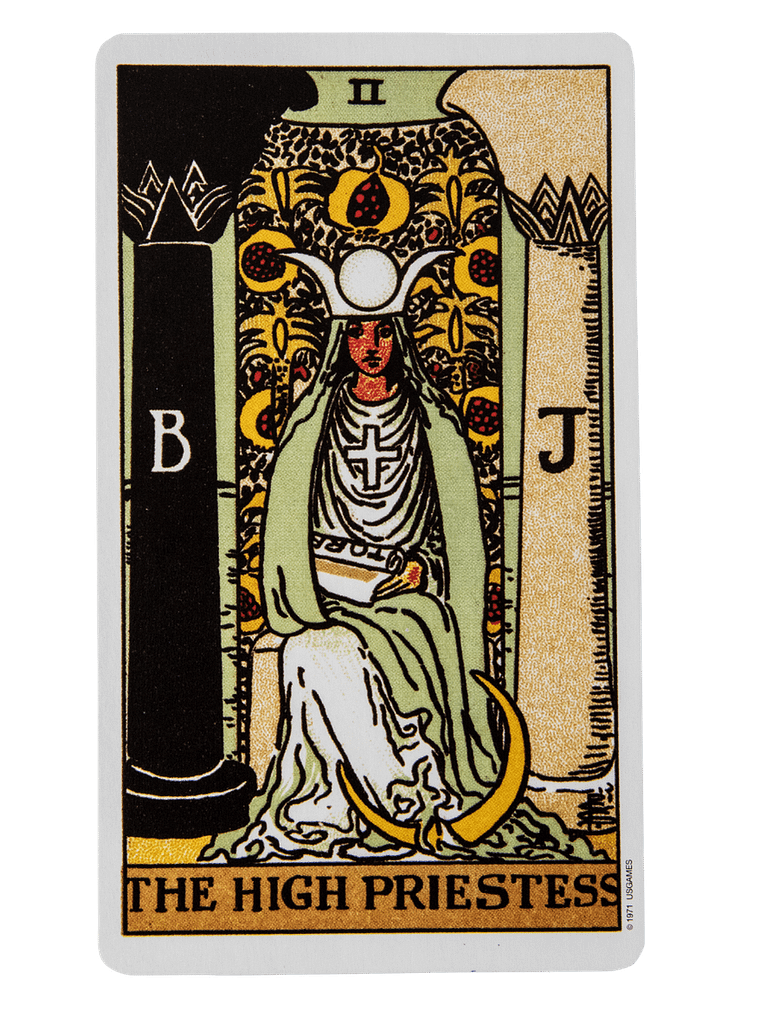
Symbolism and Accessibility
Waite wanted the deck to contain secrets, and it does. The problem is, a lot of those secrets are hidden behind layers of Christian, alchemical, and Kabbalistic symbolism.
For some readers, this is a rich source of depth. For others, it’s a barrier. If you’re not familiar with these traditions, the imagery can feel cryptic. Even the card titles sometimes use archaic language that can alienate newcomers.
There’s an ongoing tension in tarot: between honouring tradition and making it accessible. The Rider-Waite deck sits right at that tension point, which is both its strength and its weakness.
Addressing the Legacy
The Rider-Waite deck isn’t perfect, and it doesn’t have to be. Acknowledging its flaws doesn’t mean dismissing its impact. It means engaging with tarot as something dynamic and evolving.
Deck creators today are building on its foundation while making changes. Some keep the structure but update the characters. Others invent entirely new systems, inspired by Rider-Waite but not bound to it.
The most respectful thing we can do with legacy is to use it, challenge it, and expand it. That’s what keeps tarot alive.
Reimagining the Rider-Waite
Decks That Preserve the Layout but Update the Imagery
Modern Witch Tarot
This deck stays true to the Rider-Waite layouts but reimagines the figures as diverse, powerful women and femmes. Its aesthetic is bold, stylish, and contemporary, offering a feminist lens on familiar scenes. The symbolism is near-identical, which makes it an easy transition for Rider-Waite readers who want better representation.
Four Twenty Tarot
This deck mirrors the structure of the Rider-Waite Tarot Deck, card for card. But the lens is stoner-friendly and grounded in everyday life. Imagery includes herbal medicine, cannabis culture, and gentle introspection. It keeps the foundational layout while radically shifting the tone.
Queer Tarot
Created by Ash + Chess, this deck keeps the traditional layout but centres queer experiences and identities. It’s bright, expressive, and unapologetically LGBTQ+. The cards feel both classic and deeply personal, bringing queerness into the mainstream structure of tarot.
The Weiser Tarot
The Weiser Tarot is a faithful update of the original Rider-Waite Tarot Deck. It retains the exact structure and composition, but sharpens the linework, enriches the colours, and refreshes the look for a modern audience. Think of it as a respectful restoration rather than a remake.
Decks That Draw from the Imagery but Break the Layout
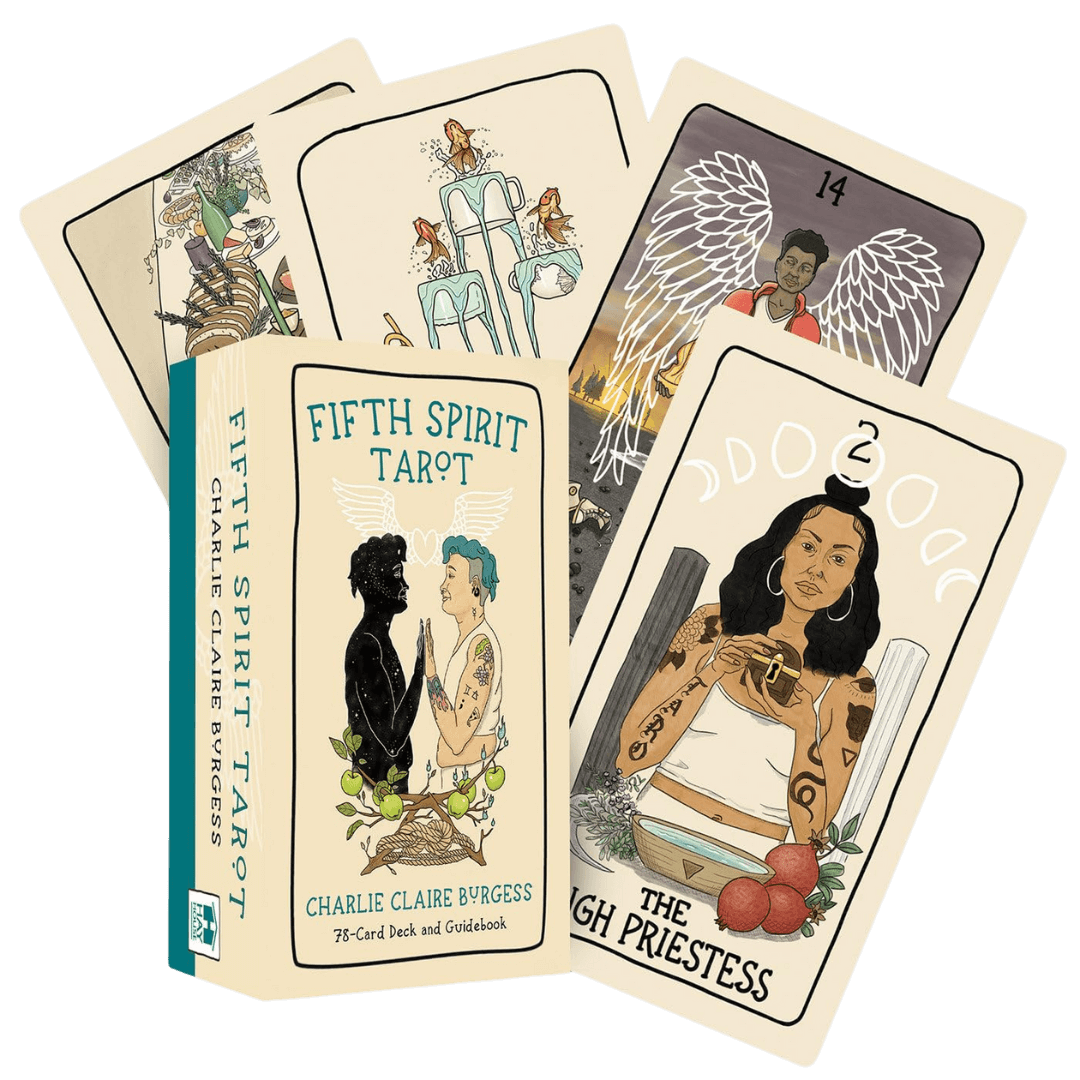
This Might Hurt Tarot
Inspired by Rider-Waite but not beholden to it, this deck updates scenes for the modern world. Characters wear jeans, ride bikes, and use smartphones. While the symbolic roots are visible, the presentation is fresh and grounded. It’s a deck that feels alive in the here and now.
Fifth Spirit Tarot
This deck is a queer, non-binary reimagining of the Rider-Waite tradition. The suits are renamed, the characters are androgynous or gender-diverse, and the scenes often break away from the original compositions. Yet the emotional and symbolic lineage is unmistakable. It’s a tribute and a departure at the same time.
A Teaching Tool and Tarot Standard
The Rider-Waite-Smith Tarot Deck in Books and Courses
Most tarot books still use the Rider-Waite-Smith deck as their visual reference. Even when discussing different decks, the core meanings and examples often draw from Rider-Waite imagery.
Courses, especially those for beginners, lean on it because of its clear symbolism and widespread recognition. It has become the standard framework for understanding tarot, even for those who later branch out.
Whether you study tarot through books, workshops, or YouTube, chances are you’re learning Rider-Waite at some level.
My Own Use in Teaching and Writing
In my own tarot course, Simply Tarot, I use the Rider-Waite Tarot Deck as the foundation. It’s accessible, visual, and layered with meaning. It gives learners something solid to work with while inviting deeper exploration.
All of the tarot card meaning pages on my website are also based on this deck. I use the imagery to guide interpretations and help others develop fluency in reading the cards. The Rider-Waite-Smith deck is my home base.
Even if I sometimes use other decks in readings, I return to Rider-Waite for clarity, teaching, and structure.
Why the Rider-Waite Tarot Deck Still Matters
Ubiquity and Accessibility
It’s often the first deck people buy. It’s the one that shows up in Google searches, Instagram posts, and pop culture. That ubiquity means readers can develop a shared visual language across traditions and locations.
Because the symbolism is so widely known, you can find resources, interpretations, and discussions almost anywhere. That makes it easier for beginners and enriching for more advanced readers.
The Rider-Waite Tarot Deck is accessible not just in tone but in availability. It’s printed, reprinted, and translated across the world.
Foundations for Further Exploration
Learning this deck is like learning Latin before studying Romance languages. It gives you the building blocks for understanding countless other decks, even ones that deviate from the original structure.
It builds confidence. It teaches pattern recognition. It lays a foundation that can support you whether you stick with it or branch out.
Even readers who abandon Rider-Waite later often return to it when they want to brush up, explain a concept, or compare systems. It remains the tarot lingua franca.
Legacy with Caveats
This isn’t a deck to worship. It’s a deck to learn from, build on, and maybe outgrow. It doesn’t need to be perfect to matter.
Its flaws make room for evolution. Its strengths provide scaffolding for creativity. And its legacy includes not just what it was, but what it made possible.
Using the Rider-Waite Tarot Deck doesn’t mean you agree with everything about it. It means you’re part of a conversation that began over a century ago.
Looking Ahead
The Rider-Waite Tarot Deck changed tarot forever. It brought symbolism to the surface, invited new readers in, and set a standard still in use today.
Whether you love it or critique it (or both), it’s worth reflecting on what this deck has meant to you. What did it teach you? What did it open up? What might you do differently?
In the next post in this series, I’ll be exploring the Thoth Tarot, a radically different beast with its own esoteric flavour. If the Rider-Waite is the public school teacher of tarot, the Thoth is the chaotic alchemist who smells faintly of absinthe.
And if you want to go deeper into Rider-Waite symbolism, check out my tarot card meanings or my beginner course, Simply Tarot.

